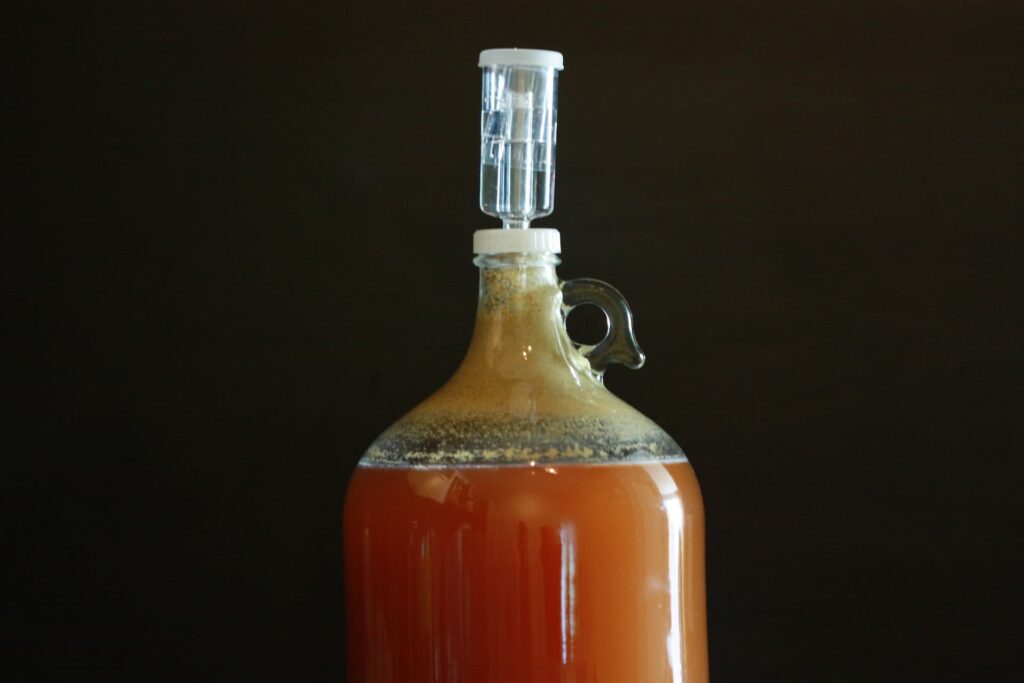If you buy something through a link in our posts, we may get a small share of the sale.
Degassing is removing dissolved carbon dioxide from the mead. Carbon dioxide is produced during fermentation and can give your mead a fizzy, champagne-like taste if not removed. Degassing also helps to remove unwanted flavors and improve the overall flavor of your mead. Therefore, understanding how to degas mead is essential.
Contents
How to Degas Mead
The simplest and most effective way to degas your mead is to gently shake or swirl the carboy. This will create bubbles that help release the carbon dioxide and introduce oxygen into the mead. Oxygen is important for the fermentation process. The swirling should be gentle enough to create bubbles and not too vigorous that it would introduce too much oxygen and cause oxidation.
Degassing should always occur during the primary fermentation stage before transferring the mead to a secondary fermenter or bottling. This is because primary fermentation is when most carbon dioxide is produced. Therefore, if you degas during primary fermentation, there will be less carbon dioxide to remove later.

The headspace always plays an essential role in degassing. The larger the headspace, the easier it is for the carbon dioxide to escape. This is why using a carboy or a wide-mouth container is important. It also helps to have a long, thin neck on the container so the gas can escape more easily.
Other Ways to Degas Your Mead
There are a couple of other ways to degas your mead that will give brewers options if they don’t want to swirl or shake their carboy. The following are six different ways to degas your mead:
Using a Vacuum Pump
This is one of the most popular ways to degas your mead. It’s also one of the quickest methods. You only need a vacuum pump and a stopper that fits snugly on your carboy or fermenter.
To use this method, place the stopper on your carboy and attach the vacuum pump. Turn on the pump and wait until it has reached its full vacuum strength. You will know it has reached its full vacuum when the mead starts to bubble.
Keep the pump running until the bubbling has stopped. This usually takes about 5-10 minutes. Once the bubbling has stopped, turn off the pump and remove the stopper. You must do this quickly to avoid losing all the vacuumed air. One thing to keep in mind with this method is that you need to be careful not to over-pump your mead.
Letting the Mead Sit
Letting mead sit is another popular way to degas it. This method is often used by brewers who don’t want to invest in a vacuum pump. To do this, simply let your mead sit undisturbed for 24 hours. This will give the CO2 time to escape on its own.
After 24 hours, carefully transfer your mead to another container, being careful not to splash or stir it. You can repeat this process a few times if needed. The only downside to this method is that it can take days or even weeks for all the carbon dioxide to escape.
Using a Degassing Rod
A degassing rod is a long, thin rod inserted into the mead. It uses electricity to create bubbles, which help release CO2. To use this method, simply insert the degassing rod into your mead and turn it on. Run it for 5-10 minutes or until the bubbling has stopped.
This method is similar to a vacuum pump; however, it doesn’t require a stopper or anything else. The rod also doesn’t need to be removed after use. The only downside to this method is that it can introduce oxygen into your mead, so it’s important to be careful.
Using a Soda Siphon
A soda siphon is a small, handheld device that can be used to degas your mead. It works by using a small amount of CO2 to create bubbles, which help release the Co2 in your mead.
To use this device, open the valve of your soda siphon and place it in your mead. Next, suck using your mouth until you see bubbles from the siphon.
Once the bubbles start, stop sucking and close the valve while maintaining the siphon in the mead. This will ensure only CO2 comes out and, at the same time, prevents oxygen from entering the mead.
Rack Your Mead
Racking is the process of transferring your mead from one container to another. This is often done to remove Sediment from the bottom of the fermenter. Racking can also help degas your mead because it exposes more surface area to the air, allowing CO2 to escape.
To rack your mead, simply transfer it from one container to another. Be careful not to splash or stir the mead while doing this. You can repeat this process a few times if needed.

Use a Blow-Off Tube
A blow-off tube is a tube that is placed in the mead and vented to the air. This allows CO2 to escape while keeping oxygen out.
To use a blow-off tube, place the tube in your mead and attach it to an airlock. Next, vent the airlock into the air. This will allow carbon dioxide to escape while preventing oxygen from entering the mead. The only downside to this method is that it can be messy. If you don’t have an airlock, you can use a balloon or a piece of tubing.
Importance of Degassing Mead
Every mead maker desires to have a clear, sparkling beverage at the end of the fermentation process. Most people believe filtering the mead is the only way to achieve this. However, this is not the case. Degassing is just as important, if not more so. The following are some of the benefits of degassing mead:
- Prevents spoilage: When mead is bottled without being degassed, the carbon dioxide produced during fermentation can cause the bottles to explode.
- Improves flavor: When mead is degassed, it allows oxygen to interact with the beer, which can help improve the taste.
- Allows for long-term storage: If mead is not degassed, the carbon dioxide will continue to be produced, which can cause the mead to go bad over time.
- Makes filtering easier: A degassed mead is always very to filter because there are no bubbles that can clog the filter.
Related Questions
How Long Does It Take to Degas Mead?
It takes 3-4 months to degas mead. This is because the mead needs to be bottled and left to age. The longer the mead is left, the more time it has to degas.
Is Degassing Necessary?
Yes, degassing is necessary to improve the flavor of your mead. It also allows for long-term storage and prevents spoilage. Once you degas your beer, you will be able to enjoy it for years to come. There are many ways to degas your to help you achieve the perfect taste.
Conclusion
Removing Co2 from mead is an important step in the brewing process. It helps to improve the flavor and allows for long-term storage. With a little patience, you will have a delicious, sparkling beverage that you can enjoy for years to come.

